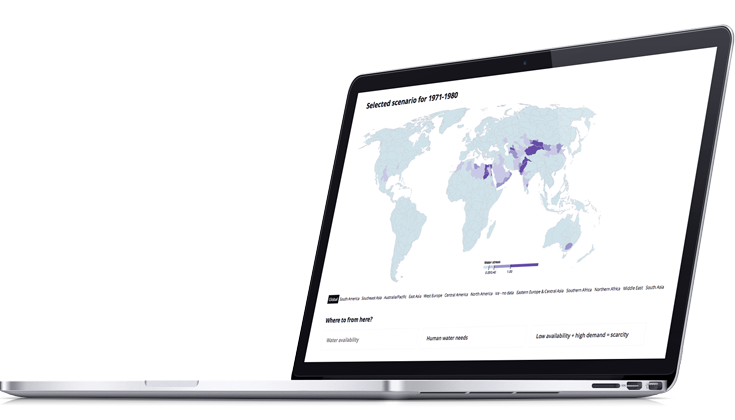Water is a fundamental resource for life, recognised as a human right. Avoiding water shortages is a key aspect of managing water scarcity.
Featured analysis
A simple way of assessing water shortage is to estimate how much water is available per person in rivers, lakes and aquifers (“blue” water), and then judge whether that value is too low. This provides a first assessment, before thinking about complex questions like defining what is a ‘need’ vs ‘want’, or defining what it means to have easy access to water.
Interpretation:
- Low values mean that some of the local population’s water needs cannot be met with locally available water, e.g. household or water supply security, food security, minimum water levels or water quality, or ecosystem services
- Shortage doesn’t just occur if water availability is low. It can also occur if population is high.
- Rain and soil moisture also provide extra “green” water, but is difficult to control compared to water that is pumped from rivers, lakes and aquifers.
- Some needs can be met by importing products, e.g. food. This provides extra “virtual” water, but also makes the local population dependent on other regions
- High values do not necessarily mean a region is self-sufficient. They may be dependent on water flowing from upstream
- Analyses often distinguish between low shortage (1700 m3/person), moderate shortage (1000 m3/person) and high shortage (500 m3/person). These thresholds are only indicative – a way of highlighting potential hotspots before analysing the situation in more detail.
The increase in water shortage is driven mainly by population growth – water availability has not changed much. However, it is the areas with low water availability that see shortages first because there is less water to share around. A rearranged version of this indicator (its inverse), is interpreted as a “water crowding index”.
Water shortage can be thought of as population-driven scarcity, while water stress is demand-driven. Shortage can occur even with a small water demand if population is sufficiently high and water availability sufficiently low. Water demand may be low because needs are not being met, or the region is using green water or is importing water-dependent products.
In principle, water shortage can be avoided by keeping population low – within the “carrying capacity” of the local resources. In practice, if water availability is low, the solution is generally to find ways to increase supply (including virtual water and desalination) and to improve efficiency of its use. This analysis only includes the effect of local infrastructure and storage – it shows the base case before more substantial adaptation.
In general, water shortage often seems to be tolerated – local populations find solutions to meet their needs rather than being limited by local resources. Keeping track of the solutions being used is therefore important in evaluating whether human right to water is being met. In many regions, this analysis therefore suggests that unaccounted solutions are likely in use, rather than saying that water really is insufficient.
Key assumptions:
The interpretation of the indicator changes depending on how water availability and use are calculated. Other results can be viewed in the exploration tool. For the results shown:
- Water availability is estimated using the WaterGap2 model, with the setup for the publication by Kummu et al. 2016. A number of other models could be used. At global scale, models are required to get a consistent dataset over time and space – harmonising observed data. The data is then:
- aggregated to the level of “Food production units” (as shown on the map). Within these regions, we assume the water can be moved around (in pipes, tankers, buckets…), and that water from outside these regions would only be used after stress does occur. If we use a larger area, we assume water can be moved further, which increases the water available and reduces stress.
- summed over decades. We assume it is possible to store water (e.g. reservoirs, water tanks, aquifers) or products (e.g. food) so that water surpluses in one month or year can be used in another, but capacity is not large enough to store water or products over more than 10 years
- allocated between regions proportional to discharge, in large basins – rather than water being available only where it rains, some of the water is accessible to downstream regions. In reality, water availability depends on actual upstream water withdrawals and water allocation rules.
- Population is given by the HYDE dataset, averaged over each decade, and are assumed to share the water resource within each “Food production unit”

Dig deeper!
Explore this data in a full interactive visualisation - change assumptions, zoom in to specific regions and see the role of water availability vs population
Water shortage
Water shortage refers to situations where there is insufficient local water to meet human needs.
Further reading
Submit a topic?
Have you done research related to water scarcity? Send us some information and we may publish your research in the Water Scarcity Atlas. Please email us at info@waterscarcityatlas.org
Feedback
Want to give us a feedback? Send us an email at info@waterscarcityatlas.org